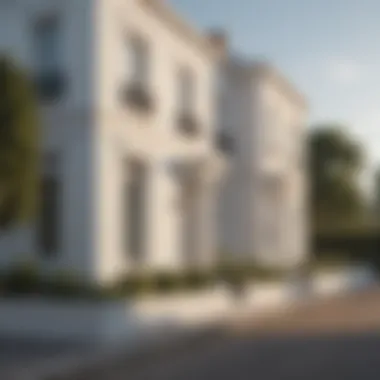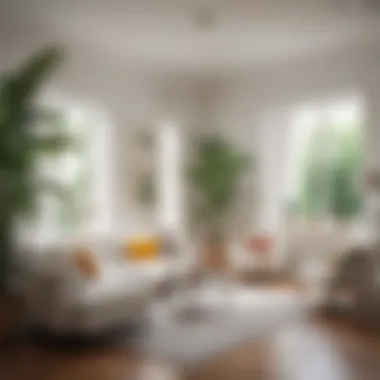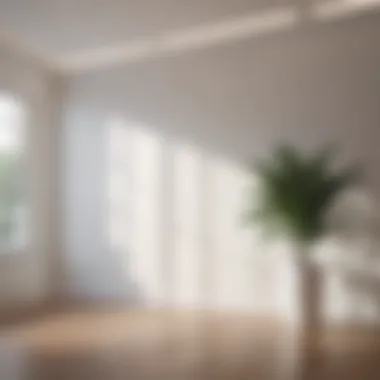The Evolution and Significance of Painting Your House White


Intro
The decision to paint a house white has deeper roots than mere aesthetics. It is an expression of identity, a reflection of surroundings, and a commitment to cultural significance. This article examines not just the historical context of white houses but also delves into practical elements like energy efficiency and maintenance. While it may seem like a simple choice, understanding the various layers behind this decision can enlighten homeowners, designers, and even those with an interest in gardening.
By exploring aesthetics, psychological impacts, and environmental effects, this guide aims to inform a wide audience. Whether you seek to redesign your space or simply understand the trends around you, grasping the significance of white in architecture can be profoundly engaging.
Preamble to the Color White
The choice to paint a house white carries a weight of significance that transcends mere aesthetics. In this section, we delve into the various layers that comprise the importance of white as a color in home design. White is not simply a shade; it embodies ideas of purity, simplicity, and spaciousness. Homeowners often select white for its capacity to create an illusion of larger spaces and its ability to reflect light, enhancing natural illumination inside and out. Additionally, this shade often becomes a canvas upon which other design elements can shine.
Furthermore, understanding the implications of painting a house white informs homeowners of its cultural and emotional resonance. This color has different meanings across various societies and time periods. In some contexts, it symbolizes a fresh start or new beginnings, making it a popular choice for many. Knowing these associations can help in making a conscious decision about a home’s exterior, adding to its overall narrative.
Understanding Color Psychology
Color psychology plays a pivotal role in how occupants and visitors perceive a space. White is often linked to serenity and peace, fostering a calming environment. When a home is painted white, it can evoke feelings of cleanliness and tranquility. Research supports these notions, suggesting that environments dominated by white can promote positive mental states. This effect can be particularly beneficial in living spaces, promoting a sense of relaxation.
Moreover, white allows flexibility in decor choices. Homeowners can easily change their interior design without being constrained by the wall colors. This adaptability makes white a preferred choice for many, enhancing the ability to cater to varied design preferences through time.
Cultural Interpretations of White
Cultural contexts add another layer of depth to understanding the color white. In Western cultures, white is often associated with weddings and purity, reflecting a positive connotation. However, its significance shifts in other regions. For instance, in parts of Asia, white symbolizes mourning and loss. This duality highlights the complexity of using white in design choices, reminding homeowners to consider their surrounding cultural implications.
Awareness of these interpretations can guide design decisions, fostering a connection between the occupants and their environment. By being mindful of how white is perceived in various cultures, homeowners can create spaces that resonate positively on multiple levels.
"Color is the keyboard, the eyes are the harmonies, the soul is the piano with many strings." – Wassily Kandinsky
Historical Context of White Houses
Understanding the historical context of white houses offers insight into how certain styles and choices evolved over time. The tradition of painting houses white is not merely a contemporary aesthetic preference but is deeply rooted in architectural history. In many cultures, white houses were synonymous with sophistication and cleanliness. They symbolize purity and dominance among other colors.
White Houses in Architecture
The use of white in architecture can be traced back to ancient civilizations. For instance, the ancient Greeks favored white marble in their structures. This choice reflected their ideals of beauty and harmony. Notably, the Parthenon in Athens exemplified this preference. The classicism seen in Greek architecture has influenced many western designs.
In America, white houses became quite iconic during colonial times. Many colonial homes were painted white, a practice rooted in practicality as well. Whitewash was easier to produce and apply than colored options. However, it quickly became associated with status. Landowners often painted their homes white to convey wealth and prosperity.
Furthermore, white houses often graced the designs of prominent institutions and public buildings. Notably, the White House in Washington D.C. stands as a monumental symbol of power and governance. It reflects the architectural movement of the time, which emphasized symmetry and classical ideals.
In contemporary design, white appears in varying styles. From minimalist aesthetics in modern homes to sprawling, traditional estates, the color has maintained its prominence. This showcases not only adaptability but also the timeless appeal of white in residential architecture.
Evolution of White Pigments
The evolution of white pigments has played a crucial role in the history of painting houses white. Early forms of white paint were made using natural materials. For example, slaked lime and chalk were common in historical recipes. These materials were not only accessible but also cost-effective, making them popular for house painting.
As technology advanced, so did the availability and variety of white pigments. In the 19th century, lead white became prominent. It was favored for its opacity and enduring quality. However, concerns over lead toxicity eventually led to a decline in its use.
Today, a wide range of options exist for white paint. Titanium dioxide is now the standard pigment used in many formulations, offering durability and excellent coverage. These advances have provided more choices in finishes and textures, allowing homeowners to select the ideal type of white paint that suits their specific needs.
Aesthetic Considerations
The choice to paint a house white is not solely driven by a desire for aesthetic appeal; it encompasses various elements that harmonize with personal and cultural tastes. The color white conveys a sense of simplicity and elegance, making it a popular option for homeowners and designers alike. Aesthetic considerations when painting your house white invite deeper exploration of how this color interacts with design elements, enhances architecture, and creates atmosphere.
Versatility in Design


When it comes to versatility, white stands out as a color that couples well with almost any design style. From the minimalist approach to ornate decoration, white serves as a neutral backdrop that can be tailored to achieve different moods and settings.
- Modern Designs: In contemporary architecture, white can impart a sense of spaciousness and lightness. Large windows paired with white facades can create a clean, seamless transition between the indoor and outdoor environments. This is particularly effective in urban areas where space is limited, as the airy feel of white can make homes appear larger.
- Traditional Elements: On the flip side, white works beautifully with classic design elements, such as crown moldings and decorative trims. Homes with colonial or Victorian influences often feature white exteriors, which highlight intricate details and craftsmanship inherent in older architectures.
By serving as a versatile foundation, white allows homeowners to incorporate furniture and decor in a myriad of colors without clashing. Accessorizing with vibrant hues creates a striking contrast, enriching the overall aesthetic.
White in Modern vs. Traditional Settings
In modern settings, the use of white paint often leans towards a minimalist approach. Clean lines and lack of ornamentation highlight the simplicity that many homeowners crave today. White becomes a statement, reflecting a lifestyle that values order and clarity. The appeal lies in its ability to reinforce a sense of calm and focus in living spaces.
Conversely, in traditional settings, white tends to evoke a different sentiment. It signifies heritage, often associated with historical significance. Classic white homes are reminiscent of a bygone era, offering warmth through nostalgia. This timeless quality makes white a staple choice for those who wish to preserve and honor historical aesthetics.
"The beauty of white lies not just in its color but in its ability to transform environments and evoke feelings that speak to human experience."
Practical Benefits of White Paint
Painting your house white offers numerous practical benefits. It transcends mere aesthetics, providing both functional and economic advantages. Homeowners, especially, find that choosing white can have significant implications for maintenance, energy use, and even the overall longevity of the structure.
Light Reflection and Energy Efficiency
One of the most significant advantages of white paint is its ability to reflect light. Light colors, particularly white, can help keep houses cooler in warm climates by reflecting sunlight rather than absorbing it. This quality is crucial for homeowners aiming for energy-efficient living.
- Energy Savings: By reflecting sunlight, houses painted white can reduce the demand for air conditioning during hot months. As a result, this can lead to lower energy bills.
- Increased Brightness: White surfaces amplify natural light, making indoor spaces feel larger and more inviting. This can be particularly beneficial in smaller homes or areas that lack windows.
Studies suggest that lighter-colored homes have a reduced carbon footprint due to their lower energy consumption. This means that painting a house white is not only practical but an environmentally friendly choice.
Maintenance and Longevity
White paint may also confer certain benefits when it comes to maintenance and the longevity of exterior surfaces. While perceived as more challenging to keep clean, white paint can sometimes be more forgiving in terms of showing wear and tear than darker colors.
- Visibility of Damage: Minor damages or wear can be spotted quickly on a white surface. This can allow for prompt repairs, which might otherwise go unnoticed on darker shades.
- Durability of Paints: Modern advancements in paint technology mean that high-quality white paints are designed to resist fading and maintain their sheen for longer periods. This reduces the frequent need for repainting.
However, it is crucial to choose the right products. The selection of high-grade paints can enhance durability while providing the refreshing look associated with white houses. Attention to detail in prep work will also affect longevity, making proper surface preparation essential before applying white paint.
"The choice of white goes beyond aesthetic appeal; it reflects a consideration for practical benefits like energy efficiency and maintenance needs."
Understanding these practical benefits can empower homeowners to make informed decisions about their choice of exterior paint. In turn, this leads to not just a pleasing facade but also a sustainable and efficient home environment.
Environmental Implications
The choice to paint houses white reflects broader environmental considerations. Understanding how this decision influences sustainability and urban environments is essential. Painting a house white isn't merely about aesthetics; it also offers tangible benefits to our surroundings. As we face challenges like climate change and urbanization, acknowledging these implications gains importance.
Sustainability of White Paint Choices
Selecting white paint can contribute to environmental sustainability in various ways. Generally, white paint contains higher levels of reflective pigments. This enables it to reflect sunlight more effectively than darker colors, which absorb heat. Using reflective paints can reduce the need for energy-intensive cooling in warm climates. This reduction leads to a lower carbon footprint.
Moreover, sustainable white paints are increasingly available. Brands focus on low volatile organic compounds (VOCs) which are less harmful to indoor air quality. Homeowners opting for these products can combine aesthetic preferences with eco-friendly choices. In this sense, white paint serves both stylistic and environmental functions, making it a smart choice for the conscious homeowner.
"The choice of using environmentally friendly paints does not compromise quality or aesthetic; it enhances both."
Impact on Urban Heat Island Effect
Urban areas experience a phenomenon known as the Heat Island Effect. This occurs when cities become significantly warmer than their rural surroundings due to human activities and material usage. Painting buildings white can combat this effect effectively. The high reflectivity of white surfaces lowers surrounding temperatures, contributing to more pleasant urban environments.


Implementing white paint especially in densely populated areas can lead to energy savings. Lower temperatures reduce air conditioning demands, leading to decreased energy consumption from fossil fuels. As more homeowners choose white for their exteriors, local climates can improve, making cities less oppressive during hot months.
Key Points to Consider:
- Reflective white paint reduces cooling costs
- Low VOC options minimize air pollution
- Contributes positively to urban climates
In summary, the environmental implications of choosing white paint are significant. They link aesthetics to sustainability and urban improvement, providing a thoughtful approach to home design.
Color Combinations with White
Color combinations with white are fundamental in the design of a house. The choice of colors can significantly influence the overall aesthetic and emotional response to a home. White serves as a blank canvas, allowing other colors to stand out. It offers versatility and elegance, making it suitable for various design styles. Integrating the right accent and complementary colors enhances the visual appeal of a white-painted house, creating an inviting atmosphere.
Accents and Complementary Colors
Accents are essential in design as they provide contrast and dynamism. When combining white with darker colors like navy, charcoal, or emerald, it can elevate the look of the house. This contrast highlights architectural features and creates a sophisticated profile.
Using brighter colors like coral or mustard can also be effective. These vibrant hues can bring warmth and energy to the white backdrop.
Benefits of Using Accents:
- Visual Interest: Accents break the monotony of white can add layers.
- Depth and Dimension: It creates shadows and highlights, enhancing the three-dimensionality of the structure.
- Highlighting Features: Specific features can be brought forward, engaging the viewer’s eye strategically.
Choosing complementary colors is about harmony. If warm whites are used, they pair well with earthy tones like beige and taupe, creating a cozy, inviting feel. Cool whites can align beautifully with shades of grey or blue, echoing a more serene and modern space.
Landscaping Considerations
The surroundings of a white house play a vital role in its overall impression. Landscaping can enhance its aesthetic appeal significantly. Planting greenery, such as lush shrubs or vibrant flowers, provides a contrast to the neutrality of white. This interaction can soften hard edges and integrate the house into its environment more comfortably.
Key Factors for Landscaping with White Houses:
- Seasonal Colors: Choosing plants that bloom in different seasons ensures year-round visual interest.
- Texture Variation: Incorporating varying textures in landscaping materials, such as rocks or tiles, can add complexity to the overall appearance.
- Scale and Proportion: Larger plants or trees can help frame the house and provide balance against the white walls.
An effectively designed landscape not only complements the white paint but also enhances the home’s character. Overall, the selection of color combinations when painting a house white requires careful thought. The right choices can articulate a homeowner's taste while promoting a harmonious connection between the structure and its environment.
Potential Drawbacks of White
Choosing to paint a house white encompasses a range of aesthetic and practical considerations. However, this decision is not without its drawbacks. A thoughtful exploration of these potential concerns ensures that homeowners can make informed decisions tailored to their individual contexts. Understanding the limitations of white paint can lead to better preparation and expectations.
Challenges in Maintenance
White houses often require more upkeep compared to houses painted with darker colors. Dirt, dust, and other environmental elements tend to show more prominently on white surfaces. This necessitates frequent cleaning to maintain appearance. In locations with heavy traffic or industrial activity, the impact of pollutants can significantly mar the beauty of a white exterior.
Furthermore, the paint can fade over time due to UV exposure, necessitating periodic repainting to restore its original brilliance. Even insects can be more visible on a white backdrop, adding to the maintenance burden. Homeowners should also consider using high-quality paint designed for durability. While it may come at a premium, it can ultimately save time and resources in the long run by reducing the frequency of maintenance.
Perceptions of Sterility
While the color white may evoke a sense of cleanliness and freshness, it can also lead to unwanted perceptions of sterility and coldness. Many homeowners want their properties to feel warm and inviting, but a predominantly white exterior might give off a clinical vibe. This often leads to an unwelcoming atmosphere, particularly in residential neighborhoods.
Moreover, white houses can sometimes lack the character that more colorful homes possess. This can affect resale value. Buyers might perceive a stark white home as less cozy or personal, impacting their emotional connection to the property.
Painting Techniques for a White Finish
Using white paint on a house is a choice that involves good preparation and techniques. Getting the finish right is critical. This section explains the necessary steps homeowners and designers must take when painting a house white, focusing on surface preparation and paint selection.


Surface Preparation
Before applying white paint, surface preparation is essential. Neglecting this can lead to poor finishes or repainting sooner than needed. Begin by cleaning the surface. Dirt, soot, and dust can prevent paint from adhering correctly. Using a pressure washer or simply scrubbing with soap and water can help. Let the surface dry thoroughly.
Next, assess the existing surface. Any peeling paint must be scraped off. Sanding smooths rough areas. Priming is also essential. Using a primer compatible with the chosen paint will ensure even coverage. White paint can show imperfections easily. A good primer will hide these and create a good base. Make sure to select a primer that suits the material of the house, whether it is wood, stucco, or metal.
Taking the time to properly prepare the surface enhances the overall quality of the paint job, which is particularly important when white is chosen.
Choosing the Right Paint
Choosing the correct type of paint is critical for achieving a high-quality white finish. Not all white paints are the same. They differ in shades, finishes, and formulation. Consider first the shade of white. Options like pure white, off-white, or warm white create different affects depending on the lighting and surrounding landscape. For exmple, pure white can appear stark, while off-white can look softer and more inviting.
Secondly, the type of finish matters. A flat finish absorbs light and helps hide imperfections but is less durable. Gloss and semi-gloss finishes reflect more light. They resist stains and are easier to clean, making them practical for high-traffic areas.
When possible, use paint that has some additional features. For instance, eco-friendly options are increasingly available. These paints have lower volatile organic compounds (VOCs). They are better for health and the environment.
In summary, by focusing on surface preparation and selecting the right paint, homeowners can greatly enhance the appearance of their white-painted houses. Proper techniques not only improve aesthetics but also longevity, making the choice of white paint a practical one.
Case Studies of White Houses
The discussion surrounding the significance of painting houses white is enriched by specific case studies. These examples offer a lens into how white houses manifest in diverse contexts. Analyzing contemporary and historic instances provides insight into not only aesthetic choices but also deeper cultural and environmental implications. Homeowners, designers, and enthusiasts can grasp a more tangible understanding of the attributes associated with white houses through these case studies.
Contemporary Examples
In modern architecture, white houses often reflect minimalist design trends. Notable contemporary examples can be seen in cities like Los Angeles and Copenhagen. The Barbara Bestor-designed house in Silver Lake encapsulates this approach. Its stark white facade stands out among the lush greenery, creating a dialogue between nature and architecture.
Another example is the MVRDV’s "The Floating Gardens" in the Netherlands. The white structures offer not only a sleek appearance but also create a visual sensation of openness. This project emphasizes how the choice of white enhances the feeling of spaciousness and contributes to urban planning that prioritizes light and air.
These examples highlight a trend towards sustainability in design as well. The use of energy-efficient materials is commonly paired with white paint to boost reflectivity. This feature helps reduce cooling costs in warmer climates, making white houses not just visually appealing but also economical over time.
Historic White Houses
Historically, white houses convey a myriad of meanings. The White House in Washington, D.C. serves as the most prominent example. Its white exterior symbolizes transparency and democracy. This architectural decision dates back to the building’s completion in the early 19th century. White paint was chosen for practical reasons, as it offered protection against the elements while also inviting a sense of dignified authority.
English colonial homes also often featured white exteriors. A prominent characteristic of this style was the use of lime wash, providing a durable and visually striking finish. The choice to paint these houses white reflects a borrowing from classical architecture, where harmony and order were paramount.
Additionally, the Agrarian Style homes built in the 18th and 19th centuries often painted white illustrate a connection with the ideals of simplicity and community. These buildings were often located in rural areas, reflecting the values and aspirations of their inhabitants.
These historical references show that painting houses white is not merely a trend but a deeper cultural expression that has evolved through time. The implications of white paint reach beyond aesthetics, affecting social identity and historic legacy.
"The color white is not just about appearance; it’s a bridge between tradition, culture, and modernity."
In summary, case studies of both contemporary and historic white houses reveal their significance. They provide a straightforward understanding of why this choice persists. The enduring appeal lies in both function and symbolism, making white a lead choice for various types of residences.
Culmination
The choice to paint a house white encapsulates numerous considerations that resonate strongly with both aesthetics and functionality. Throughout this article, we explored the significance behind painting houses white, emphasizing its historical context, aesthetic versatility, and practical advantages.
Summary of Key Points
- Aesthetic Appeal: White serves as a blank canvas that allows for flexibility in design choices, complementing various styles from modern to traditional.
- Historical Significance: White houses have a rich history, evident in notable architectural examples that have withstood the test of time.
- Psychological Effects: The color white often evokes feelings of cleanliness, simplicity, and spaciousness, making it a popular choice for many homeowners.
- Practical Benefits: From increased energy efficiency to lower maintenance concerns, painting a house white offers tangible benefits that enhance home value.
- Environmental Considerations: The implications of white paint also extend to environmental aspects, including urban heat reduction and sustainability in material choices.
By weaving these facets together, the decision to paint a house white emerges as a thoughtful one that reflects the values, preferences, and practical needs of homeowners.
Final Thoughts on Painting White
Choosing to paint a house white goes beyond mere aesthetic appeal. It serves as a symbol of style, tradition, and consciousness about modern living and environment. For homeowners, it can enhance the perceived value of the property while allowing for creative expression.
As the world increasingly leans towards environmentally friendly choices, the advantages associated with white painting, such as heat reflection and energy savings, make it an even more attractive option. Homeowners aiming to unify their exterior with the surrounding landscape will find that white provides a gentle yet sophisticated touch.



